You can listen to Hoosier History Live! live on the air each Saturday, or listen online at the WICR website during the broadcast on any computer with speakers, anywhere, or on a smartphone. We invite you to visit our website!
March 3 show
Union Station history in Indy
 For the first time in American history, competing railway lines came together in a single central train depot, the country's first "union" station. It happened in Indianapolis in 1853, six years after the first railroad reached the Hoosier capital.
For the first time in American history, competing railway lines came together in a single central train depot, the country's first "union" station. It happened in Indianapolis in 1853, six years after the first railroad reached the Hoosier capital.
The opening of Union Depot helped account for explosive growth in Indy and the city's longtime "Crossroads of America" nickname.
During the 1880s, the initial depot was replaced by a nearby, majestic Union Station designed in Romanesque Revival architectural style with elegant Rookwood tiles in its interior and a 185-foot clock tower that became a city landmark.
To discuss the history of the station listed on the National Register of Historic Places - as well as the impact of the railroads on Indy - Nelson will be joined in studio by architectural photographer Garry Chilluffo of Chilluffo Photography. Garry, who often is a commentator on tours of the station, also is the corporate photographer for Crowne Plaza Union Station.
Today the historic train shed houses a Crowne Plaza luxury hotel, and the restored grand hall is a ballroom, with rooms in the former concourse serving as convention meeting rooms. (Hotel guests may stay in historic Pullman cars that have been converted to suites and named after famous people who traveled through the train station, such as Winston Churchill, Cole Porter and Amelia Earhart.)
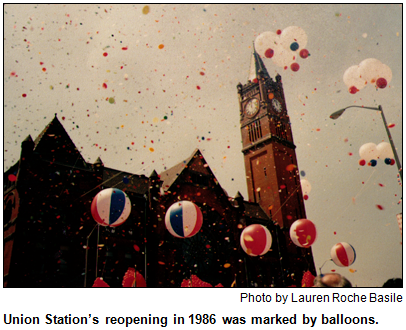 Garry will share insights about how train travel initially was considered unsafe - with good reason. Even so, its popularity soared, with Indianapolis serving as a major cross-country hub.
Garry will share insights about how train travel initially was considered unsafe - with good reason. Even so, its popularity soared, with Indianapolis serving as a major cross-country hub.
According to Indianapolis Union Station (2000, Guild Press of Indiana), by Jim Hetherington, in the three years after the arrival of the first railroad, the city's population more than doubled, increasing to 8,091 residents. By 1852, the population had soared to 10,800; in 1870, it was 48,224.
More than 200 trains passed through Union Station daily by 1910. Rail travel peaked in the 1920s, when famous Americans (ranging from politicians and movie stars to athletes and authors) who traveled by train east of the Mississippi River usually were routed through Union Station. In 1922, 6 million travelers passed through it.
"So many trains steamed in and out of Union Station during the heyday of the railroads that some had to wait for others to move out before they could even enter the station," Jim Hetherington notes in his history of the landmark.
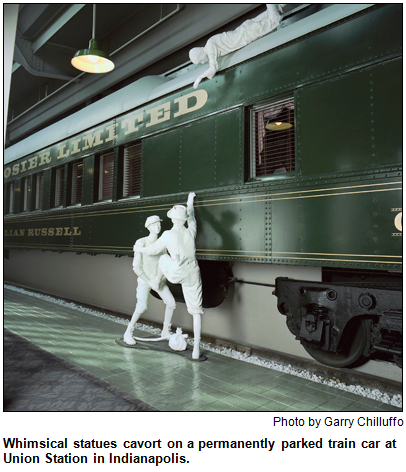 After the 1920s, train travel declined with the widespread availability of cars. World War II, though, sparked a major revival at Union Station in part because of restrictions on gasoline and the mass movements of American servicemen.
After the 1920s, train travel declined with the widespread availability of cars. World War II, though, sparked a major revival at Union Station in part because of restrictions on gasoline and the mass movements of American servicemen.
Next came another, steeper decline in train travel. By 1967, only 16 trains per day came through Union Station, according to a "Culture Watch" column in the Indianapolis Star by historian James Glass.
In 1986, a $48 million restoration and redevelopment of Union Station into a festival marketplace proved unsuccessful, but the National Register designation protects the magnificent structure from demolition. Its interior includes a bronze plaque in the head house that pays tribute to the initial Union Depot, as well as more than two dozen "Ghost People" - white fiberglass sculptures representing the thousands of passengers who traveled through Union Station in its heyday.
Fun facts:
 Garry, who enjoys shooting restoration photography of Indiana landmarks, collaborated with Nelson and photo historian Joan Hostetler on the Indianapolis Then and Now (2004, Thunder Bay Press) visual history book. It features a photo of Santa Colossal, a 51-foot high Styrofoam replica of Santa Claus that "spoke" yuletide greetings to thousands of passengers at the terminal during the late 1940s. ("Santa" was so popular that postcards with his image were handed out at Union Station for years afterward.)
Garry, who enjoys shooting restoration photography of Indiana landmarks, collaborated with Nelson and photo historian Joan Hostetler on the Indianapolis Then and Now (2004, Thunder Bay Press) visual history book. It features a photo of Santa Colossal, a 51-foot high Styrofoam replica of Santa Claus that "spoke" yuletide greetings to thousands of passengers at the terminal during the late 1940s. ("Santa" was so popular that postcards with his image were handed out at Union Station for years afterward.)- Union Station sparked explosive growth in the nearby Wholesale District, which featured several outdoor marketplaces in the late 1800s and early 1900s. Also nearby was an area of hotels and boardinghouses known as "the Levee" that eventually got a reputation as seedy.
- In 1864, a teenager named Thomas Edison worked at Union Station as a telegraph operator. He was fired from his job in part for devoting too much time to his inventions, as we learned in a Hoosier History Live! show last May about Edison's connections to Indiana with playwright Hank Fincken, who often portrays the inventor.
History Mystery
En route from Illinois to his presidential inauguration in 1861, Abraham Lincoln stopped at Union Depot, the predecessor train station to Union Station. During his stay in Indianapolis, President-elect Lincoln made a significant speech from the balcony of a local hotel.
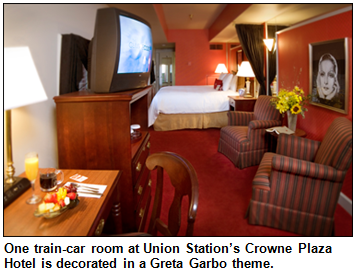 Located at Washington and Illinois streets, the hotel was considered the city's finest during Lincoln's stay. But in the early 1900s, it was demolished to make way for a much grander hotel, the Claypool Hotel.
Located at Washington and Illinois streets, the hotel was considered the city's finest during Lincoln's stay. But in the early 1900s, it was demolished to make way for a much grander hotel, the Claypool Hotel.
Question: Name the historic hotel in Indianapolis where President-Elect Lincoln stayed in 1861.
To win the prize, you must call in with the correct answer during the live show and be willing to be placed on the air. Please do not call if you have won a prize from any WICR show during the last two months. The call-in number is (317) 788-3314, and please do not call until you hear Nelson pose the question on the air.
Friends, we are continuing to receive a lot of interest in the History Mystery. Please be polite on the phone to our engineers and to our host!
In honor of this week's show topic, the prize is one night in a deluxe room at Crowne Plaza Hotel Indianapolis Union Station in downtown Indianapolis. All aboard! This prize is courtesy of the ICVA.
Roadtrip: Tyson Temple in Versailles
Roadtripper Chris Gahl of the ICVA will tell us about an Art Deco gem that sits right smack dab in the middle of the southeastern Indiana town of Versailles in Ripley County. And yes, it is called Ver-SALES in Indiana, as opposed to the French pronunciation of the word for that magnificent palace just a little west of Paris, France, which was occupied by Louis XIV and Marie-Antoinette prior to their beheading in the French Revolution.
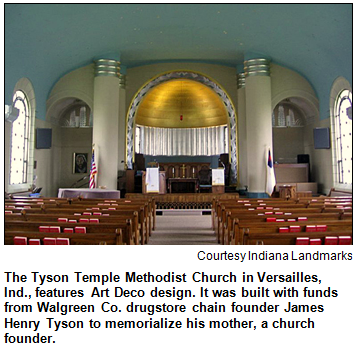 But forgive the digression into French history. James Henry Tyson, a native of Versailles, Ind., and a devout Methodist, was co-founder of the Walgreen Drug Co. and had the Tyson Methodist Temple commissioned and built in memory of his mother, a charter member of the town's United Methodist congregation.
But forgive the digression into French history. James Henry Tyson, a native of Versailles, Ind., and a devout Methodist, was co-founder of the Walgreen Drug Co. and had the Tyson Methodist Temple commissioned and built in memory of his mother, a charter member of the town's United Methodist congregation.
The ceiling in the temple's interior is designed to resemble the look of the night sky the day Tyson's mother died. And no hammers were used in its construction because "no hammers were heard" in the construction of Israel's Holy Temple.
The church continues to be an active Methodist congregation, and visitors are welcome at Sunday services. Tours can be arranged by calling (812) 689-6976 or visiting the church's website.
While in Versailles, be sure to stop by the lovely Versailles State Park. This Roadtrip was recommended by Connie Zeigler.
Your Hoosier History Live! team,
Nelson Price, host and creative director
Molly Head, producer, (317) 927-9101
Chris Gahl, Roadtripper
Richard Sullivan, webmaster and tech director
Pam Fraizer, graphic designer
Garry Chilluffo, creative consultant
Michele Goodrich, Jed Duvall, grant consultants
Joan Hostetler, photo historian
Dana Waddell, volunteer-at-large
www.hoosierhistorylive.org

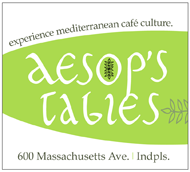



Please tell our sponsors that you appreciate their support: Aesop's Tables, Indiana Historical Society, Indiana Authors Award, Lucas Oil and Story Inn.
 Acknowledgments to Print Resources, Indianapolis Marion County Public Library, Monomedia, Indiana Humanities, Indianapolis Convention & Visitors Association, WICR-FM, Fraizer Designs, Heritage Photo and Research Services, Derrick Lowhorn, Samantha Stratton and many other individuals and organizations. We are an independently produced program and are self-supporting through organizational sponsorships, grants and through individual tax-deductible contributions through the Indiana Humanities Council. Visit our website to learn how you can support us financially.
Acknowledgments to Print Resources, Indianapolis Marion County Public Library, Monomedia, Indiana Humanities, Indianapolis Convention & Visitors Association, WICR-FM, Fraizer Designs, Heritage Photo and Research Services, Derrick Lowhorn, Samantha Stratton and many other individuals and organizations. We are an independently produced program and are self-supporting through organizational sponsorships, grants and through individual tax-deductible contributions through the Indiana Humanities Council. Visit our website to learn how you can support us financially.
March 10 show
James Alexander Thom and Dark Rain on historical fiction
 Acclaimed far and wide for the depth of his historic research - his novels have sold more than 2 million copies around the world - James Alexander Thom is the best-known author currently living on Indiana soil. In this encore broadcast of a popular show from our Hoosier History Live! archives, Nelson is visited in studio by this legendary Hoosier, who prefers to be called Jim.
Acclaimed far and wide for the depth of his historic research - his novels have sold more than 2 million copies around the world - James Alexander Thom is the best-known author currently living on Indiana soil. In this encore broadcast of a popular show from our Hoosier History Live! archives, Nelson is visited in studio by this legendary Hoosier, who prefers to be called Jim.
He is a nature lover who lives in a 19th-century log cabin that he moved and reconstructed himself on a ridge near a forest in Indiana's Owen County. Also joining in is Jim's wife, Dark Rain Thom, a Shawnee elder, tribal historian and fellow author.
Jim shares insights and challenges about writing historical fiction. His novels have included Follow the River, which hit the New York Times bestseller list in 1981, and Panther in the Sky (1989), about the great Shawnee leader Tecumseh.
The Indiana Magazine of History called him a "master of the form" in a review of Jim's newest book, The Art and Craft of Writing Historical Fiction (Writer's Digest Books).
 Dark Rain, who served on the Lewis and Clark Bicentennial Planning Council, and Jim also are the co-authors of Warrior Woman (2004), a novelistic portrait of a real-life female Shawnee leader of the 1770s.
Dark Rain, who served on the Lewis and Clark Bicentennial Planning Council, and Jim also are the co-authors of Warrior Woman (2004), a novelistic portrait of a real-life female Shawnee leader of the 1770s.
During this memorable show (its original broadcast date was April 2, 2011), Nelson talks to the husband-and-wife team about myths concerning the Shawnee, as well as their historic home.
A native of Owen County, Jim did much of the reconstruction work himself on the cabin, reassembling it log by log, using material from the 1800s, and sleeping in a tent during the process. (During that stretch, he wrote at night by kerosene light.)
Jim's other bestsellers have included Long Knife (1979), about the exploits of George Rogers Clark during the Revolutionary War, and Sign-Talker (2000), which focuses on a French-Shawnee scout who provided invaluable assistance to Lewis and Clark.
In addition, Dark Rain is the author of Kohkumenthena's Grandchildren (1994), a history of the Shawnee.
Not only are the Thoms' admirers legion, we can't resist noting Jim won the inaugural Indiana Authors Award in 2009, given by the Indianapolis Public Library Foundation.
© 2012 Hoosier History Live! All rights reserved.